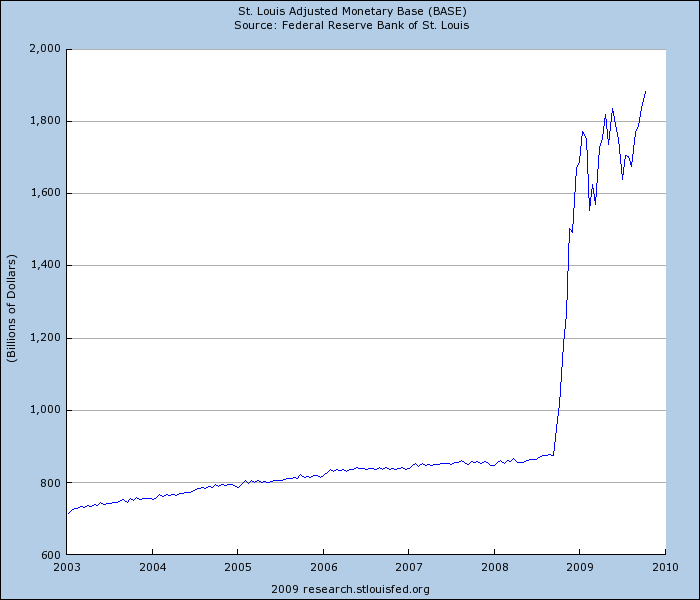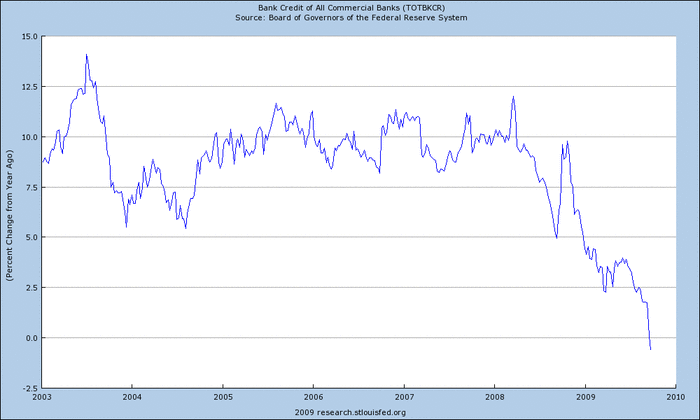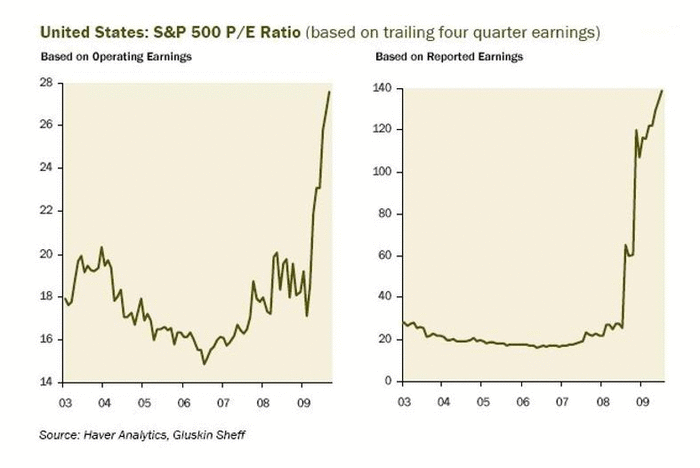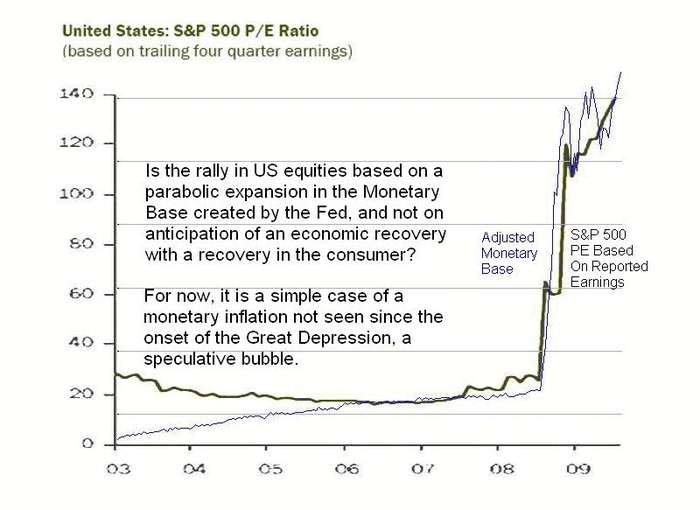
Dynamics

|
Generational Dynamics |
| Forecasting America's Destiny ... and the World's | |
| HOME WEB LOG COUNTRY WIKI COMMENT FORUM DOWNLOADS ABOUT | |
This is another refutation of Richard Koo's stimulus theories.
An analysis posted on the "Jesse's Café Américain" blog provides an explanation for the current stock market bubble that's been soaring since March. The analysis shows that stimulus, bailout and quantitative easing money from the government is highly correlated to the current stock market bubble, implying that this government money is pouring into stocks and boosting this new bubble.
The following graph of the adjusted monetary base provides an indication of the amount of money that's been injected into the economy by means of bailouts, stimulus and quantitative easing:
 |
The above graph shows that the monetary base has expanded from $900 billion in late 2008 to $1.9 trillion today, a $1 trillion increase in the last year.
But where has that $1 trillion gone?
In the past, I've posted several discussions on presentations by Richard C. Koo, Chief Economist at Nomura Research Institute, on the experience of the 1930s Great Depression and the 1990-2005 "lost decade" in Japan. (See, for example "Fiscal stimulus programs in 1930s and today.")
The theory presented by Koo is the entire basis in mainstream macroeconomic theory justifying the large stimulus programs being implemented by the Obama administration, as well as by countries around the world. As explained in the Koo presentations, this theory is based on the following assumption: That the stimulus money will first create jobs, and then will return to the Treasury in the form of bond purchases, because there's nowhere else for the money to go.
So where has all the money gone?
It certainly hasn't gone into bank lending, as the following graph shows:
 |
The above graph shows that bank lending has plummeted, even as $1 trillion in bailouts, stimulus and quantitative easing has poured into the economy.
This is what's expected from Koo's concept of "balance sheet recession," his name for a deflationary spiral. During such a period, assets are destroyed, but debts remain, so everyone is in debt. People and businesses refuse to go even deeper into debt, and instead of spending any money they have, they either save it or use it to pay down debt. Either way, it goes into a bank, which (according to Koo) uses the money to purchase government bonds, thus returning the money to the Treasury. But the bank does not risk lending the money out, which is consistent with the above graph.
But what if the money was somehow being used to buy stocks? There's certainly a correlation, as shown by the following graphs of the S&P 500 price/earnings ratio (also called "valuations"):
 |
Notice that the as-reported P/E ratios began skyrocketing at exactly the same time that the stimulus money started pouring out. Also notice that the operating earnings P/E ratio has also been soaring.
(For a discussion of "operating" versus "as reported" earnings, see "Wall Street Journal sharply revises its fantasy price/earnings computations.")
The following graph overlays the monetary base with the reported earnings P/E ratio:
 |
These graphs show that the bailouts, stimulus and quantitative easing are highly correlated with this years stock market bubble. Correlation doesn't imply causation, of course, but the size and duration of this year's stock market bubble has been extremely puzzling, and this correlation provides a highly credible explanation.
This is an extremely significant conclusion because it strikes at the heart at the macroeconomic justification for the massive stimulus programs. For stimulus to work, it's absolutely essential that the stimulus money create jobs and then come back into the Treasury through saving and debt reduction.
If the money is being channeled into the stock market, then much of it will "leak" out of the country into investments in other countries, thus defeating the purpose of the stimulus.
How much longer can this go on? How long can the Fed and the Treasury pour out hundreds of billions of dollars to expand the stock market bubble? That can't be predicted, of course, but every bubble has to burst some time, and all it would take is some surprise event to trigger a panic.
The "Jesse's Café Américain" article contains another interesting chart:
 |
The current stock market bubble correlates with bailouts and stimulus:
This is another refutation of Richard Koo's stimulus theories....
(14-Oct-2009)
The effects of massive fiscal stimulus - Part II:
President-elect Barack Obama is turning apocalyptic in his speeches....
(12-Jan-2009)
The economic outlook for 2009 :
How we got to where we are today, who's to blame, and where we're going in 2009.
(5-Jan-2009)
The effects of massive fiscal stimulus.:
A study comparing Japan's deflationary spiral with ours shows the way....
(24-Dec-2008)
| ||
I've often wondered about the wealth disparity and income inequality statistics. I've been reading for years that income inequality has been increasing, and I felt intuitively that this had to be related to the generational financial cycle.
This graph supports the conclusion that income inequality is a generational trend. It seems that income inequality increases substantially during the generational stock market, real estate and credit bubbles, and then presumably crashes along with the stock market.
In fact, we can think of wealth disparity as just one more bubble that's still growing today, and will crash along with the other bubbles.
I was shocked earlier this year when Citibank, Bank of America and other banks announced that they would continue paying million dollar bonuses. These and other banks had caused the financial crisis by creating worthless structured securities and fraudulently selling them to investors. Paying big bonuses to people who defrauded the public for years is, at the very least, a public relations disaster.
What's become apparent in the last few months is that this disaster goes far beyond simple public relations. Citibank, Bank of America and other banks have been screwing and gouging their own customers in order to provide the cash flow to justify the million dollar bonuses. Stories abound about banks arbitrarily raising interest rates to 30%, doubling or tripling minimum payments, or engineering phony fees of hundreds or thousands of dollars per customer.
In one sense, this should be no surprise at all. The same people who made billions of dollars selling worthless structured securities to investors are now making billions of dollars by gouging their own customers. They've changed only their methods, not their patterns of behavior.
As I've mentioned several times on this web site, when I was growing up in the 1950s, my parents and my teachers really hated bankers, but I never understood why. I sure understand why today. Bankers did exactly the same kinds of things in the 1930s that they're doing today. Many bankers went to jail by the end of the 1930s, and the rest of them were hated for decades.
If you look at the narrative that I've presented in this article, you can see some ironies. These banks have received hundreds of billions of dollars in bailout money, and are benefiting from the stimulus and quantitative easing programs. They aren't lending any of this money to consumers, since credit card defaults might reach as high as 10-15%, and they're evidently not investing the cash in safe Treasuries. Instead, a lot of the money is being channeled into stock market bubble, and when that bubble bursts, they're going to lose much more money than they would have from credit card defaults.
That's not all. If you look at the last graph above, the wealth disparity graph, and you see what happened in the 1930s, then you can predict what's going to happen before long now. That wealth disparity is going to disappear, as the Principle of Maximum Ruin catches up with the bankers who have been perpetrating all these misdeeds, defrauding investors and gouging customers. It's a modern morality play.
From the point of view of Generational Dynamics, you can see how the circle is closing. I know that long-time readers of this web site are sick and tired of hearing me endlessly talk about the "The nihilism and self-destructiveness of Generation X," and how the lethal combination of greedy, nihilistic Gen-Xers, along with greedy, incompetent Boomers, has brought about the current financial disaster.
Now we're beginning to see how the people in this lethal combination used destruction and nihilism to lay the seeds for their own self-destruction. Not only will most of them lose all their ill-gotten wealth, but many of them will go to jail. The rest will be hated for decades.
To that end, a significant criminal trial began on Tuesday. Two former Bear Stearns executives, Ralph Cioffi and Matthew Tannin are charged with securities fraud and face 20 years in prison if convicted.
It's no surprise that Bear Stearns executives defrauded investors. (See, for example, "Bear Stearns bails out defaulting hedge funds, preventing broad market meltdown.") But there's increasing momentum in public opinion building that people who perpetrated this fraud should be punished, just like the 1930s.
As I've said many times, there's no doubt whatsoever that fraud was rampant. It was absolutely clear by 2006 that the real estate bubble was bursting, and that the computerized risk models that had been used to justify the creation of mortgage-backed structured securities were based on incorrect assumptions. If investment bankers had been honest, then they would have warned their investors that something was wrong. Instead, they redoubled their efforts to sell these securities (now called "toxic assets"), paying themselves huge commissions for each sale. Thus, there's absolutely no doubt at all that massive fraud was going on. However, this is all circumstantial evidence, not enough to convict anyone in court.
And political figures are just as guilty as investment bankers. This has nothing to do with any political party. You have Robert Rubin from the Clinton administration, Henry Paulson from the Bush administration, and Larry Summers from the Obama administration -- all of them made many millions of dollars participating in this fraud, and they're still running things. Journalists are to blame as well. They've lied about this fraud because they didn't want to lose advertisers.
In the Ralph Cioffi / Matthew Tannin case that begins today, prosecutors have obtained the e-mail messages they exchanged in March 2007. These messages indicate that they were telling each other that the funds were likely to crash, while they were telling investors that they were solid. If prosecutors obtain a conviction against Cioffi and Tannin, then they will have opened the door to obtaining convictions against other investment bankers.
This brings us back to the original subject of this article. Cioffi and Tannin are typical of an entire generation of investment bankers, real estate execs, politicians, journalists, and others who believe that rules don't apply to them, and they're allowed to screw anyone they want to make as much money as they want. The bailout, stimulus and quantitative easing money is supposed to be used for consumer loans and job creation. Instead, it's being channeled into the stock market bubble, undoubtedly by people who are paying themselves fat commissions for brokering stock purchases. This causes even more damage to the economy in general, and encourages ordinary investors to invest in the bubble, and risk losing everything.
In other words, the same people who created the financial crisis for their own gain are now prolonging and worsening the financial crisis, for their own gain.
(Comments: For reader comments, questions and discussion,
see the Financial Topics thread of the Generational Dynamics forum. Read
the entire thread for discussions on how to protect your money.)
(14-Oct-2009)
Permanent Link
Receive daily World View columns by e-mail
Donate to Generational Dynamics via PayPal
Web Log Summary - 2016
Web Log Summary - 2015
Web Log Summary - 2014
Web Log Summary - 2013
Web Log Summary - 2012
Web Log Summary - 2011
Web Log Summary - 2010
Web Log Summary - 2009
Web Log Summary - 2008
Web Log Summary - 2007
Web Log Summary - 2006
Web Log Summary - 2005
Web Log Summary - 2004
Web Log - December, 2016
Web Log - November, 2016
Web Log - October, 2016
Web Log - September, 2016
Web Log - August, 2016
Web Log - July, 2016
Web Log - June, 2016
Web Log - May, 2016
Web Log - April, 2016
Web Log - March, 2016
Web Log - February, 2016
Web Log - January, 2016
Web Log - December, 2015
Web Log - November, 2015
Web Log - October, 2015
Web Log - September, 2015
Web Log - August, 2015
Web Log - July, 2015
Web Log - June, 2015
Web Log - May, 2015
Web Log - April, 2015
Web Log - March, 2015
Web Log - February, 2015
Web Log - January, 2015
Web Log - December, 2014
Web Log - November, 2014
Web Log - October, 2014
Web Log - September, 2014
Web Log - August, 2014
Web Log - July, 2014
Web Log - June, 2014
Web Log - May, 2014
Web Log - April, 2014
Web Log - March, 2014
Web Log - February, 2014
Web Log - January, 2014
Web Log - December, 2013
Web Log - November, 2013
Web Log - October, 2013
Web Log - September, 2013
Web Log - August, 2013
Web Log - July, 2013
Web Log - June, 2013
Web Log - May, 2013
Web Log - April, 2013
Web Log - March, 2013
Web Log - February, 2013
Web Log - January, 2013
Web Log - December, 2012
Web Log - November, 2012
Web Log - October, 2012
Web Log - September, 2012
Web Log - August, 2012
Web Log - July, 2012
Web Log - June, 2012
Web Log - May, 2012
Web Log - April, 2012
Web Log - March, 2012
Web Log - February, 2012
Web Log - January, 2012
Web Log - December, 2011
Web Log - November, 2011
Web Log - October, 2011
Web Log - September, 2011
Web Log - August, 2011
Web Log - July, 2011
Web Log - June, 2011
Web Log - May, 2011
Web Log - April, 2011
Web Log - March, 2011
Web Log - February, 2011
Web Log - January, 2011
Web Log - December, 2010
Web Log - November, 2010
Web Log - October, 2010
Web Log - September, 2010
Web Log - August, 2010
Web Log - July, 2010
Web Log - June, 2010
Web Log - May, 2010
Web Log - April, 2010
Web Log - March, 2010
Web Log - February, 2010
Web Log - January, 2010
Web Log - December, 2009
Web Log - November, 2009
Web Log - October, 2009
Web Log - September, 2009
Web Log - August, 2009
Web Log - July, 2009
Web Log - June, 2009
Web Log - May, 2009
Web Log - April, 2009
Web Log - March, 2009
Web Log - February, 2009
Web Log - January, 2009
Web Log - December, 2008
Web Log - November, 2008
Web Log - October, 2008
Web Log - September, 2008
Web Log - August, 2008
Web Log - July, 2008
Web Log - June, 2008
Web Log - May, 2008
Web Log - April, 2008
Web Log - March, 2008
Web Log - February, 2008
Web Log - January, 2008
Web Log - December, 2007
Web Log - November, 2007
Web Log - October, 2007
Web Log - September, 2007
Web Log - August, 2007
Web Log - July, 2007
Web Log - June, 2007
Web Log - May, 2007
Web Log - April, 2007
Web Log - March, 2007
Web Log - February, 2007
Web Log - January, 2007
Web Log - December, 2006
Web Log - November, 2006
Web Log - October, 2006
Web Log - September, 2006
Web Log - August, 2006
Web Log - July, 2006
Web Log - June, 2006
Web Log - May, 2006
Web Log - April, 2006
Web Log - March, 2006
Web Log - February, 2006
Web Log - January, 2006
Web Log - December, 2005
Web Log - November, 2005
Web Log - October, 2005
Web Log - September, 2005
Web Log - August, 2005
Web Log - July, 2005
Web Log - June, 2005
Web Log - May, 2005
Web Log - April, 2005
Web Log - March, 2005
Web Log - February, 2005
Web Log - January, 2005
Web Log - December, 2004
Web Log - November, 2004
Web Log - October, 2004
Web Log - September, 2004
Web Log - August, 2004
Web Log - July, 2004
Web Log - June, 2004